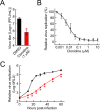Stimulation of alpha2-adrenergic receptors impairs influenza virus infection
- PMID: 29545586
- PMCID: PMC5854622
- DOI: 10.1038/s41598-018-22927-0
Stimulation of alpha2-adrenergic receptors impairs influenza virus infection
Abstract
Influenza A viruses cause seasonal epidemics and occasional pandemics. The emergence of viruses resistant to neuraminidase (NA) inhibitors and M2 ion channel inhibitors underlines the need for alternate anti-influenza drugs with novel mechanisms of action. Here, we report the discovery of a host factor as a potential target of anti-influenza drugs. By using cell-based virus replication screening of a chemical library and several additional assays, we identified clonidine as a new anti-influenza agent in vitro. We found that clonidine, which is an agonist of the alpha2-adrenergic receptor (α2-AR), has an inhibitory effect on the replication of various influenza virus strains. α2-AR is a Gi-type G protein-coupled receptor that reduces intracellular cyclic AMP (cAMP) levels. In-depth analysis showed that stimulation of α2-ARs leads to impairment of influenza virus replication and that α2-AR agonists inhibit the virus assembly step, likely via a cAMP-mediated pathway. Although clonidine administration did not reduce lung virus titers or prevent body weight loss, it did suppress lung edema and improve survival in a murine lethal infection model. Clonidine may thus protect against lung damage caused by influenza virus infection. Our results identify α2-AR-mediated signaling as a key pathway to exploit in the development of anti-influenza agents.
Conflict of interest statement
Ken Matsui, Toshihiko Maekawa, and Minoru Kubota are employees of Fujifilm Corporation. The other authors declare that they have no conflicts of interest associated with this manuscript. Yoshihiro Kawaoka is a founder of FluGen. This study was funded, in part, by Fujifilm Corporation. The funder had no role in the study design, data collection and interpretation, or the decision to submit the work for publication.
Figures





Similar articles
-
In vitro evaluation of synergistic inhibitory effects of neuraminidase inhibitors and methylglyoxal against influenza virus infection.Arch Med Res. 2015 Jan;46(1):8-16. doi: 10.1016/j.arcmed.2014.12.002. Epub 2014 Dec 15. Arch Med Res. 2015. PMID: 25523147
-
Comparison of the Efficacy of N9 Neuraminidase-Specific Monoclonal Antibodies against Influenza A(H7N9) Virus Infection.J Virol. 2018 Jan 30;92(4):e01588-17. doi: 10.1128/JVI.01588-17. Print 2018 Feb 15. J Virol. 2018. PMID: 29167344 Free PMC article.
-
Reduction of Neuraminidase Activity Exacerbates Disease in 2009 Pandemic Influenza Virus-Infected Mice.J Virol. 2016 Oct 14;90(21):9931-9941. doi: 10.1128/JVI.01188-16. Print 2016 Nov 1. J Virol. 2016. PMID: 27558428 Free PMC article.
-
Bat lung epithelial cells show greater host species-specific innate resistance than MDCK cells to human and avian influenza viruses.Virol J. 2018 Apr 10;15(1):68. doi: 10.1186/s12985-018-0979-6. Virol J. 2018. PMID: 29636078 Free PMC article.
-
Application of α2 -adrenergic agonists combined with anesthetics and their implication in pulmonary intravascular macrophages-insulted pulmonary edema and hypoxemia in ruminants.J Vet Pharmacol Ther. 2021 Jul;44(4):478-502. doi: 10.1111/jvp.12960. Epub 2021 Mar 12. J Vet Pharmacol Ther. 2021. PMID: 33709435 Review.
Cited by
-
The Association of an Alpha-2 Adrenergic Receptor Agonist and Mortality in Patients With COVID-19.Front Med (Lausanne). 2022 Jan 4;8:797647. doi: 10.3389/fmed.2021.797647. eCollection 2021. Front Med (Lausanne). 2022. PMID: 35059419 Free PMC article.
-
Beyond Antivirals: Alternative Therapies for Long COVID.Viruses. 2024 Nov 19;16(11):1795. doi: 10.3390/v16111795. Viruses. 2024. PMID: 39599909 Free PMC article. Review.
-
In Vitro and In Vivo Antiviral Activity of Nylidrin by Targeting the Hemagglutinin 2-Mediated Membrane Fusion of Influenza A Virus.Viruses. 2020 May 25;12(5):581. doi: 10.3390/v12050581. Viruses. 2020. PMID: 32466302 Free PMC article.
-
Receptor-Loaded Virion Endangers GPCR Signaling: Mechanistic Exploration of SARS-CoV-2 Infections and Pharmacological Implications.Int J Mol Sci. 2021 Oct 11;22(20):10963. doi: 10.3390/ijms222010963. Int J Mol Sci. 2021. PMID: 34681624 Free PMC article. Review.
-
SARS-CoV-2 and the sympathetic immune response: Dampening inflammation with antihypertensive drugs (Clonidine and Propranolol).Med Hypotheses. 2020 Nov;144:110039. doi: 10.1016/j.mehy.2020.110039. Epub 2020 Jun 24. Med Hypotheses. 2020. PMID: 32758881 Free PMC article.
References
-
- Król E, Rychłowska M, Szewczyk B. Antivirals - current trends in fighting influenza. Acta Biochim. Pol. 2014;61(3):495–504. - PubMed
Publication types
MeSH terms
Substances
LinkOut - more resources
Full Text Sources
Other Literature Sources
Research Materials

